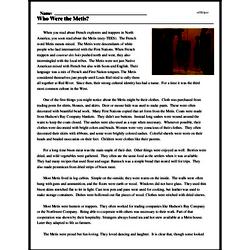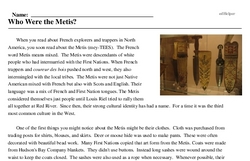Who Were the Metis?
When you read about French explorers and trappers in North America, you soon read about the Metis (mey-TEES). The French word Metis means mixed. The Metis were descendants of white people who had intermarried with the First Nations. When French trappers and coureur des bois pushed north and west, they also intermingled with the local tribes. The Metis were not just Native American mixed with French but also with Scots and English. Their language was a mix of French and First Nation tongues. The Metis considered themselves just people until Louis Riel tried to rally them all together at Red River. Since then, their strong cultural identity has had a name. For a time it was the third most common culture in the West.
One of the first things you might notice about the Metis might be their clothes. Cloth was purchased from trading posts for shirts, blouses, and skirts. Deer or moose hide was used to make pants. These were often decorated with beautiful bead work. Many First Nations copied that art form from the Metis. Coats were made from Hudson's Bay Company blankets. They didn't use buttons. Instead long sashes were wound around the waist to keep the coats closed. The sashes were also used as a rope when necessary. Whenever possible, their clothes were decorated with bright colors and beads. Women were very conscious of their clothes. They often decorated their skirts with ribbons, and some wore brightly colored sashes. Colorful shawls were worn on their heads and beaded moccasins on their feet. Children wore clothes like their parents.
For a long time bison meat was the main staple of their diet. Other things were enjoyed as well. Berries were dried, and wild vegetables were gathered. They often ate the same food as the settlers when it was available. They had many recipes that used flour and sugar. Bannock was a simple bread that stored well for trips. They also made pemmican from dried strips of bison meat.




